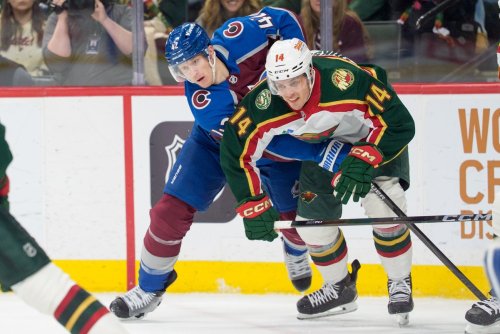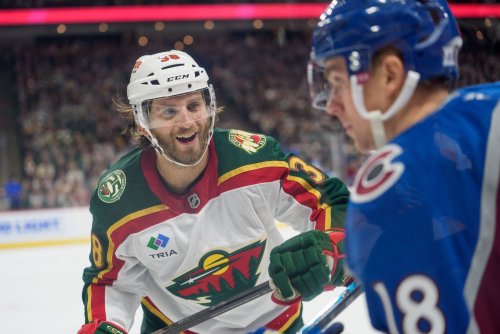
I’m likely older than you. And I think it might be because of my age that I have never caught on to listening to podcasts. I’ve tried to listen to certain podcasts, but I inevitably get distracted finding something to read online instead. I’ve had podcasts playing in the background, but it always just ends up as white noise to me. But I was intrigued by the latest Hockey Wilderness podcast because the topic was whether the Wild actually improved enough this offseason. Check it out here.
To be honest, I jumped around a bit. But from about the 26th minute to the 46 minute mark, Tony, Barry and Aaron debated whether and how much the Minnesota Wild improved over last season. They discussed the fact that many of the same players are still on the roster and with so few changes, whether the team would have the same strengths and weaknesses as last year’s version. They seem to agree, without putting words in their mouths, that the biggest change was bringing in BB as the new head coach and they thought the team might actually be improved without really improving the roster much.
And I thought about why I might be a little more optimistic about the Wild’s pending season. I think that the Wild has finally shored up the bottom six of the forward group. I agree that Bruce Boudreau was a huge get. But I also think that GMCF probably did as well as he could to improve the team over last season. And my optimism stems from the long-ass comment I made on the President’s Day Wilderness Walk using Super WOWY’s “not” function at Puckalytics to carve out the garbage the Wild were throwing over the boards in the bottom six of the lineup. And I also looked at how well the Wild played when those players were not on the ice. So, I’m taking this opportunity to do the same thing a little more formally.
Since the Wild’s defensemen and goaltenders are basically identical to the ones the Wild iced last season, we’re going to look specifically at the forward group. If you wanted to be cynical, you might guess that GMCF suddenly discovered Stats.HockeyAnalysis.com in the summer of 2016 and took shot attempt percentage as gospel. What the Wild did this summer with its forward group is slice off the worst performers via this metric and kept the best.
This is a link to a list of all Minnesota forwards who played at least 500 minutes last season, sorted by the team’s CF% when that player is on the ice. So, Nino Niederreiter, Jason Pominville, Mikko Koivu, Mikael Granlund, Zach Parise, Jason Zucker, Charlie Coyle, and Erik Haula are back. Thomas Vanek, Justin Fontaine, David Jones, Chris Porter and Jarret Stoll are gone. Ryan Carter signed a PTO recently, but hopefully that has more to do with his proximity to highway 35E from home to get to the rink in time for practice last minute, rather than filling out the roster.
The theory doesn’t hold entirely. Vanek finished slightly ahead of Haula by CF%. But whether you believe that fancy stats in hockey are glorious or bunk, if you watched the Wild last season, you know that Haula centered what was consistently the Wild’s most effective line for the last 30 games of the season between Nino and Pominville. In fact, the fancy stats bear that out as you can see from the screen shot below from Corsica.hockey that Haula’s getting steamrolled at 5-on-5 under 45% before a dramatic rise over the last quarter of the season. Haula’s also seven years younger and the Vanek buyout saved the Wild $4 million in cap space this season. Not a tough call.
So, my theory about why the Wild had a rough season last year is that there is a huge disparity between the top six forwards and the bottom six, greater than any other team in the league. First, let’s start with the fourth line, which consisted of a combination of Haula for the first 2/3 of the season, as well as Stoll, Carter and Porter. Of the 352 forwards across all teams last season that played at least 500 minutes of 5-on-5 ice time, Stoll ranked 352, Carter ranked 350 and Porter ranked 348 in CF%. As all Wild fans know from last season, the fourth line was absolutely brutal, primarily because they just don’t have any offensive skill. Of the 352 forwards, Stoll, Carter and Porter ranked in the bottom six in shot attempts for.
Now, there is an argument to be made that no team’s fan base likes its fourth line outside of Team Canada at the World Cup of Hockey and the New York Islanders, apparently. But there are 30 teams in the league running four lines made up of three players each, for a total of 360 forwards and still the Wild’s fourth line players are coming up at the bottom of that list. There’s a pretty easy argument to be made that the Wild iced the worst fourth line in the NHL last season.
The second prong of this argument is based on the fact that Vanek is a boat anchor. Both Yeo and Torch spent all of last season trying to get Vanek going offensively and nothing really took. Of the 352 forwards mentioned above, Vanek placed 314th on that list. Moreover, of the 13 Wild players that Vanek played at least 100 5-on-5 minutes last season, 10 of the 13 were worse with Vanek on the ice based on shot attempts percentage.
Last season, Vanek spent the most time on the wing with Granlund at Center. In 324 minutes of 5-on-5 play, together they posted a CF% of 45.4. Apart from Granlund, Vanek was the same at 45.4, while Granlund away from Vanek was at 51.7. Early in the season, Yeo tried Vanek with Coyle at center and they combined for a CF% of 47.0 in 293 minutes. Vanek away from Coyle was at 44.6, while Coyle away from Vanek was 47.3. Not a big difference for Coyle, playing out of position, but that’s a story for another day. Finally, in 176 minutes with Koivu, together they posted a CF% of 49.8. Away from Koivu, Vanek posted 44.4, while the Ninja away from Vanek was at 51.8. Every center was better in shot attempt percentage when Vanek was on his wing. So, for the purpose of this analysis, we’ll just call whatever line Vanek is on the third line, or bottom six.
So, if you’re still with me, how do we see what the divergence is between the Wild’s top six forwards and the bottom six? Well, if we assume that Vanek is anchoring in the mud what we’ve termed the third line and if we assume that Stoll, Carter and Porter are typically on the fourth line, we can use the Super WOWY tool at puckalytics.com to determine how the Wild played with and without those players. All numbers are CF% at 5on5.
As a team, the Wild had 3905 5-on-5 minutes of play and the CF% was 47.7. Without any of those four players on the ice the team’s CF% was 51.7. That’s basically the difference between the Wild’s 23rd place finish out of 30 teams and a top-10 finish, closer to Detroit and San Jose.
And the distinction between the Wild’s top six and bottom six forwards really shows through when you look at how the individual defensemen performed with the different forward packages on the ice. The following chart shows how each of the Wild defensemen fared with what we’ve dubbed the top six (Vanek, Stoll, Carter and Porter not on the ice) and the bottom six (Vanek, Stoll, Carter or Porter on the ice).
As you can see from the column I’ve highlighted in red, every Wild defensemen has a huge discrepancy and it’s based on solely whether or not one of those four players is or isn’t on the ice. Suter’s swing is over 10 percentage points, Folin’s is 15 (!), Prosser 11. The smallest swing is Reilly’s percentage point swing of six.
As far as I’ve been able to tell, this issue is unique to the Wild. For example, of the 352 forwards with at least 500 minutes of 5-on-5 ice time, Colorado had several finish at the bottom. So in place of the Wild’s bottom six forwards, I used Skille, John Mitchell, Marinsen and McLeod as forwards not on the ice with the four Avalanche defensemen that played at least 500 minutes at 5-on-5, and each of those defensemen had only about a four percentage point swing.
With LA, I used King, Andreoff and Lecavalier as forwards not on the ice. Martinez and Muzzin saw large swings of 8 percentage points, but the same wasn’t true of Doughty or McNabb. In any event, if you’re curious about any particular team, let me know in the comments and we can take a look together. Or just head over to www.puckalytics.com and poke around yourself. Just be careful that you don’t end up submitting ridiculously long articles to HW and/or ridiculously long comments to the Walk.
In conclusion, GMCF sought to clean up the mess in the bottom six forward group this offseason. Instead of signing players to fill those rolls with cap space the Wild doesn’t have, he chose addition by subtraction and removed from the roster the players that were a real drag on team success. As we all know, Nino Niederreiter finished second in the NHL in CF% relative to his teammates, sandwiched between wizards Bergeron and Datsyuk. Part of the reason is that Nino is awesome and we all love him very much. NIEDERREITER is an anagram for UNDERRATED … probably. But it’s also because the relative stat is comparing Nino to some players that amounted to a brutal bottom six. With those players out of the equation we will see this season whether team success follows. That’s why I’m optimistic.
All statistics used in this article courtesy of the fabulous www.corsica.hockey and www.puckalytics.com.
Think you could write a story like this? Hockey Wilderness wants you to develop your voice, find an audience, and we'll pay you to do it. Just fill out this form.








Recommended Comments
There are no comments to display.
Join the conversation
You can post now and register later. If you have an account, sign in now to post with your account.
Note: Your post will require moderator approval before it will be visible.